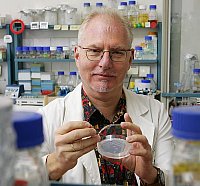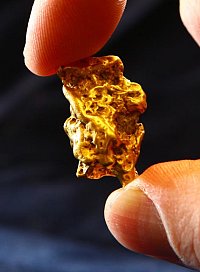Links
Contact
Prof. Dr. Dietrich H. Nies
phone: 0345 55-26352
dietrich.nies@mikrobiologie...
Director of the Institute of Biology
06120 Halle (Saale)
Bacteria turn toxins into gold
Research findings causing a stir
UTE OLBERTZ
What do bacteria and metal have in common? In fact they may share a complex relationship. Recent exciting research findings by microbiologists at the MLU show evidence of this. News that, for example, copper door handles in hospitals help reduce the spread of bacteria or that bacteria allow gold to “grow” is making headlines in the media (see scientia halensis 3/09) and was published in the journal “Proceedings of the National Academy of Sciences”.

Prof. Dietrich Nies at work in his lab, photo: Maike Glöckner
Research groups led by Prof. Dietrich Nies at the Institute of Biology discovered a while ago how “clever” bacteria are able to deactivate the toxins that are directed at them. Bacteria that are resistant to antibiotics even possess various ways of making an antibiotic ineffective. Either they transport it right out of their cells, alter it or don’t even absorb it in the first place. Bacteria work in the same way when it comes to tackling heavy metals. Many of these metals, for example zinc, are important trace elements in small amounts, however large quantities of them are toxic. Bacteria that are resistant to heavy metals survive in highly contaminated locations where the heavy metals have denatured all other organisms. These bacteria easily dispose of the heavy metal cations by ejecting them from their cells or by transforming them into base metals.
“It was discovered in 2009 that the bacterium Cupriavidus metallidurans could detoxify toxic gold complexes by transforming them into metallic gold,” explains Professor Nies. This came as a great surprise to his team which was involved in an international research project led by Frank Reith from the University of Adelaide.
BIOCHEMISTRY IN PLAY
Reith found this bacterium on gold nuggets at two locations in Australia that were 3,500 kilometres apart. In lab tests it was discovered that active biochemical processes are involved in the creation of gold nuggets. Until then it was thought that this process was purely abiotic.
Genes were identified which are apparently involved in the bio-mineralisation of gold. "Needless to say we are still unable to produce tonnes of gold," Nies says curbing any ensuing hope "because a bacterium is only a thousandth of a millimetre in size. If it were one metre large, the gold nugget would be the size of a tennis ball." Nevertheless it opens new doors for biotechnological applications for bacteria. "Maybe these research findings will one day allow gold to be made from solutions low in gold," says Nies. If nothing else, the presence of this type of bacteria in the soil reveals natural gold deposits.
COPPER FIGHTS GERMS IN HOSPITALS
Bacteria, in this case antibiotic-resistant ones, were also the topic of the "Antimicrobial Copper Surfaces" field trial, prepared and carried out at the Asklepios Klinik Wandsbek in Hamburg by its doctors and scientists from the MLU. Every year 20,000 to 40,000 people die in Germany of an infection caused by hospital germs. Reason enough to search for ways of reducing this high number of cases.
The initial results: door handles and light switches that are made of copper are an efficient and further means of stopping the spread of dangerous germs in hospitals. Researchers from the MLU took regular samples under day-to-day conditions over an extended period of time and compared the number of germs on the various contact surfaces. "Copper surfaces revealed only 63% of the number of germs found on the control surfaces, in other words conventional door handles, door plates and light switches," says Nies. "Furthermore it has been shown in practice that copper considerably reduces bacteria resettlement. The bacteria on copper surfaces die within a minute." The bacteria do have detoxification systems for copper as part of their metabolism, however they are not sufficient.
But what does the formation of gold nuggets have to do with eradicating bacteria on copper surfaces? The main task of the factors that deactivate gold complexes is to detoxify copper ions. Both elements are chemically related to one another and possess similar properties. Up until now the transformation of toxic ions into nontoxic metals by bacteria had only been observed in quicksilver - now also in gold. "If this is also the case for copper, it would mean that investigating copper resistance might reveal important insights into the creation of gold nuggets. Additionally, gold could teach us something about the previously unknown processes occurring with bacterial copper resistance," says Nies.
In the end, however, using copper in the fight again antibiotic-resistant bacteria should not result in the development of a form of bacteria that would be able to survive on copper surfaces. This would only replace one evil with another.
“ ... everything is attached to gold“

A natural gold nugget brought by Prof. Gregor Borg from eastern Congo, photo: Maike Glöckner
Gold – countless legends tell of the intoxication felt by people after they first glimpse this yellow metal. “The fact is that the masses of adventurers and gold panners in Tanzania and in eastern Congo have heavily damaged the environment,” says Gregor Borg, Professor for Petrology and Mineral Deposit Research. Entire settlements were destroyed in regions with a lot of gold because suddenly a few, small clay huts had to house more than 30,000 people, including numerous miners. Uncontrolled mining resulted, not least of which, in soil erosion and the destruction of the countryside. Up until the 1990s, gold mining in Tanzania was disordered and, in part, illegal.
Borg lived from 1988 to 1992 in Dodoma, Tanzania, training 20 Tanzanian geologists so that they could instruct companies in prospecting and mining for gold in a controlled manner and under government supervision. This was a project carried out by the Federal Institute for Geosciences and Raw Materials and was part of a programme of the Federal Ministry for Economic Cooperation and Development. Today industrial gold mining is well-developed in this region and is no longer accessible by everyone. Six to seven clean-operating gold mines are located here, one of which was discovered by Borg himself while taking samples.
“There is also gold in the ground in many regions in Saxony-Anhalt,” the geologist reveals. scientia halensis will report more about this in its next issue. Borg uses natural gold nuggets, one of which can be seen here on the left, as examples in his research and teaching. They come from Tanzania and eastern Congo. U. O.
More on the Web:
The student podcast from Uni-TV entitled “Goldbakterien für den Heimgebrauch?” [Gold bacteria for use at home?]” about the research project: http://www.uni-tv-halle.de .



